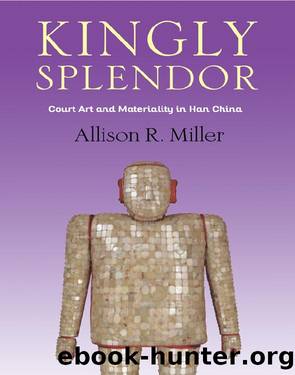Kingly Splendor by Allison R. Miller;

Author:Allison R. Miller;
Language: eng
Format: epub
Tags: ART015060, Art/History/Ancient & Classical, HIS008000, History/Asia/China
Publisher: Lightning Source Inc. (Tier 3)
Published: 2020-01-12T00:00:00+00:00
[The First Emperor] held that the Zhou dynasty had ruled by the power of fire. Since the Qin had replaced the Zhou, its power should therefore proceed from that which fire cannot overcome; the power of water had now begun its era of dominance. He changed the time for court celebrations marking the beginning of the year, holding them on the first day of the tenth month, and all clothing, flags, and pennants honoured the colour black. 26
Because Zou Yanâs disciples maintained that red and fire were associated with the Zhou, the Qin adopted water as their patron element, to signify their metaphysically legitimate ascendancy, and black as their patron color. Court clothing, banners, and flags were all dyed this color.
Yet even during an era when black was honored as the patron color, purple remained the principal color of prestige for a variety of ceremonies and important occasions, and increased in popularity. According to the histories, the gold seal with the purple cord (jinyin zishou éå°ç´«ç¶¬) was the highest seal of office. In the early Qin, this insignia was carried by the highest civil and military positions in the Qin state: the two chancellors of state (xiangguo ç¸å),27 the grand commandant (taiwei 太å°), and the generals of the van, rear, left, and right (qianhou zuoyou jiangjun åå¾å·¦å³å°è»).28 A gold seal with a purple cord was also used for the aristocratic seals of the chehou 徹侯, the highest rank out of the twenty official aristocratic ranks.29 By comparison, a silver seal with a blue-green cord was carried by officials with a salary grade of 2,000 piculs and above;30 a bronze seal with a black cord by officials with salary grades of 600 to 1,999 piculs;31 and a bronze seal with a yellow cord by officials with salary grades of 200 to 599 piculs.32
Evidence from the First Emperorâs terracotta army further supports the thesis that purple remained a color of prestige in the Qin state. Of the six major colors used to paint the terracotta warriors, green was the most popular, followed by red and then purple.33 Several of the highest-ranking figures in the army, the generals, wore long purple robes.34
Aside from this, it remains difficult to determine the overall importance attached to purple in these terracotta army figures because of the small amount of paint remaining on them and, in particular, the lack of realism employed in the figuresâ paint.35 Generally, the colors selected for the warriors were chosen for their opulence, contrast, and practicality. Green was utilized much more than any other color, most likely because of the relatively high availability of malachite compared to other pigments.36 Qin artisans also placed a high value on contrast. As Yuan Zhongyi has noted, âIf an upper garment was green then it often had a purple or red border. This would often be paired with blue or purple or red trousers.â37 Thus, the matter of prestige is hard to separate from the other deduced needs and practices surrounding color usage.
Download
This site does not store any files on its server. We only index and link to content provided by other sites. Please contact the content providers to delete copyright contents if any and email us, we'll remove relevant links or contents immediately.
Nudge - Improving Decisions about Health, Wealth, and Happiness by Thaler Sunstein(7261)
iGen by Jean M. Twenge(5168)
The Fire Next Time by James Baldwin(5032)
Adulting by Kelly Williams Brown(4243)
The Hacking of the American Mind by Robert H. Lustig(4098)
The Sports Rules Book by Human Kinetics(4084)
The Ethical Slut by Janet W. Hardy(4044)
Captivate by Vanessa Van Edwards(3733)
Mummy Knew by Lisa James(3527)
In a Sunburned Country by Bill Bryson(3376)
The Worm at the Core by Sheldon Solomon(3328)
Ants Among Elephants by Sujatha Gidla(3282)
Suicide: A Study in Sociology by Emile Durkheim(2909)
The Slow Fix: Solve Problems, Work Smarter, and Live Better In a World Addicted to Speed by Carl Honore(2849)
The 48 laws of power by Robert Greene & Joost Elffers(2818)
Humans of New York by Brandon Stanton(2694)
Handbook of Forensic Sociology and Psychology by Stephen J. Morewitz & Mark L. Goldstein(2606)
The Happy Hooker by Xaviera Hollander(2586)
The Tipping Point by Malcolm Gladwell(2566)
